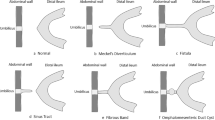Abstract
Background
Approximately 0.04% of the general population will present with a complication related to Meckel diverticulum. The classic teaching is that symptomatic children with Meckel diverticulum present with painless rectal bleeding and are evaluated with a radionuclide scan. Our subjective experience is that we see children with Meckel diverticulum who present with abdominal pain and are evaluated by CT.
Objective
We reviewed the findings on CT in children with pathologically proven Meckel diverticulum to identify characteristic patterns of presentation.
Materials and methods
Databases were searched (2004–2008) for all children who had a pathologic diagnosis of Meckel diverticulum and a CT scan performed prior to surgery. Demographics, pathology, and CT features were reviewed. CT features reviewed included: soft-tissue stranding, abnormal calcifications, bowel obstruction, free air, free peritoneal fluid, cystic mass, intussusception, obvious lead point, location, and whether a normal appendix was identified. The frequency of Meckel diverticulum encountered on CT scans was compared to that found during the same period of time on technetium pertechnetate studies.
Results
The review identified 16 subjects (mean age 9.5 years, M:F 9:7). CT findings included: soft-tissue stranding in nine (56%), small-bowel obstruction (SBO) in nine (56%), intussusception in three (19%), free fluid in ten (63%), cystic mass in four (25%), calcification in none (0%), free air in one (6%), and no abnormalities in two (13%). A normal appendix was identified in only five children (31%). There were three basic patterns of presentation of abnormalities: SBO only in five, intussusception with SBO in three, or cystic mass with inflammatory stranding in four (one with SBO). Also, 2.3 times more Meckel diverticulum was encountered on CT than on technetium pertechnetate studies.
Conclusion
Meckel diverticulum is currently more commonly encountered in children on CT performed for abdominal pain than on technetium pertechnetate studies. There are three categories of appearance on CT: SBO only, intussusception, or a cystic inflammatory mass.




Similar content being viewed by others
References
Bennett GL, Birnbaum BA, Balthazar EJ (2004) CT of Meckel’s diverticulitis in 11 patients. AJR 182:625–629
Ludtke FE, Mende V, Kohler H et al (1989) Incidence and frequency of complications and management of Meckel’s diverticulum. Surg Gynecol Obstet 169:537–542
Yahchouchy EK, Marano AF, Etienne JC et al (2001) Meckel’s diverticulum. J Am Coll Surg 192:658–662
Rossi P, Gourtsoyiannis N, Bezzi M et al (1996) Meckel’s diverticulum: imaging diagnosis. AJR 166:567–573
Leijonarck CE, Bonman-Sandelin K, Frisell J et al (1986) Meckel’s diverticulum in the adult. Br J Surg 73:146–149
Yamaguchi M, Takeuchi S, Awazu S (1978) Meckel’s diverticulum: investigation of 600 patients in Japanese literature. Am J Surg 136:247–249
Turgeon DK, Barnett JL (1990) Meckel’s diverticulum. Am J Gastroenterol 85:777–781
Daneman A, Lobo E, Alton DJ et al (1998) The value of sonography, CT and air enema for detection of complicated Meckel diverticulum in children with nonspecific clinical presentation. Pediatr Radiol 28:928–932
O’Hara SM (1996) Pediatric gastrointestinal nuclear medicine. Radiol Clin North Am 34:845–862
Mortele KJ, Govaere F, Vogelaerts D et al (2002) Giant Meckel’s diverticulum containing enteroliths: typical CT imaging findings. Eur Radiol 12:82–84
Hughes JA, Hatrick A, Rankin S (1998) Case report. Computed tomography findings in an inflamed Meckel diverticulum. Br J Radiol 71:882–883
Danzer D, Gervaz P, Platon A et al (2003) Bleeding Meckel’s diverticulum diagnosis: an unusual indication for computed tomography. Abdom Imaging 28:631–633
Levy AD, Hobbs CM (2004) Meckel diverticulum: radiologic features with pathologic correlation. Radiographics 24:565–587
Elsayes KM, Menias CO, Harvin JH et al (2007) Imaging manifestations of Meckel’s diverticulum. AJR 189:81–89
Author information
Authors and Affiliations
Corresponding author
Rights and permissions
About this article
Cite this article
Olson, D.E., Kim, YW. & Donnelly, L.F. CT findings in children with Meckel diverticulum. Pediatr Radiol 39, 659–663 (2009). https://doi.org/10.1007/s00247-008-1138-9
Received:
Revised:
Accepted:
Published:
Issue Date:
DOI: https://doi.org/10.1007/s00247-008-1138-9




